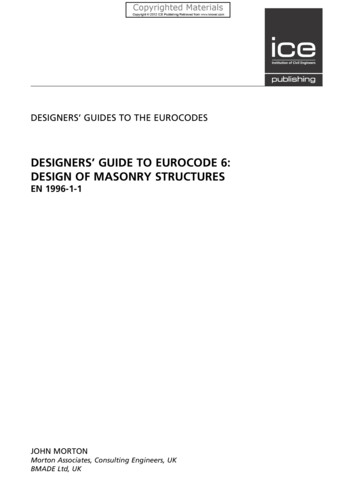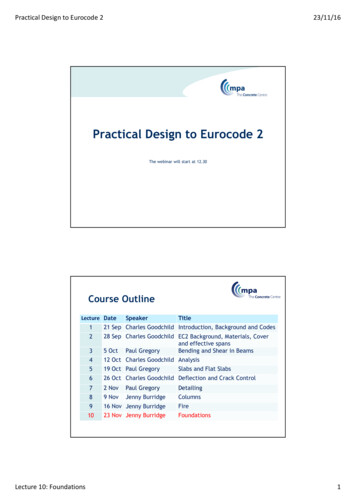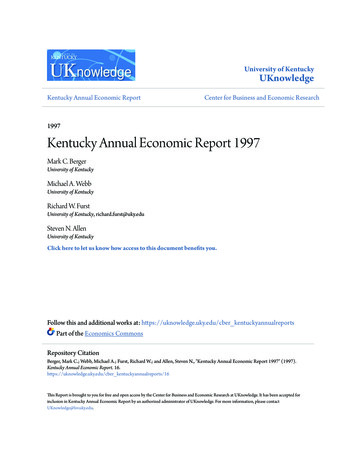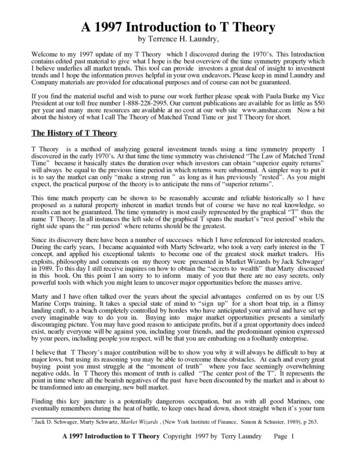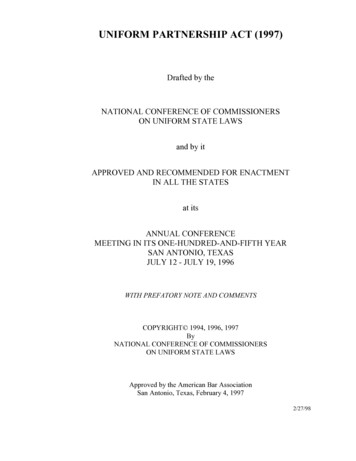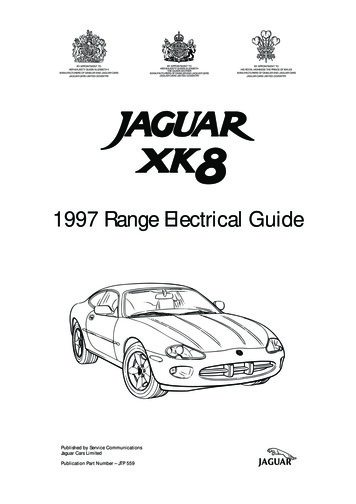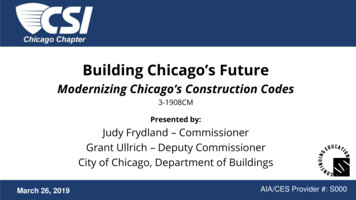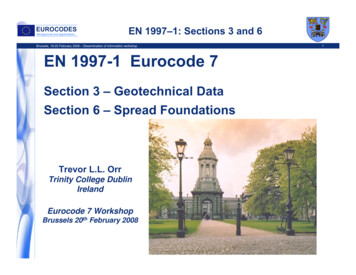
Transcription
EUROCODESBackground and ApplicationsEN 1997–1: Sections 3 and 6Brussels, 18-20 February 2008 – Dissemination of information workshopEN 1997-1 Eurocode 7Section 3 – Geotechnical DataSection 6 – Spread FoundationsTrevor L.L. OrrTrinity College DublinIrelandEurocode 7 WorkshopBrussels 20th February 2008Yourlogo1
Section 3EUROCODESBackground and ApplicationsBrussels, 18-20 February 2008 – Dissemination of information workshopEN 1997-1: Section 3Geotechnical Data2
EUROCODESBackground and ApplicationsSection 3 – OverviewBrussels, 18-20 February 2008 – Dissemination of information workshop The fact that EN 1997-1 has a separate section on Geotechnical Datademonstrates that the determination of geotechnical data is an essentialpart of the geotechnical design process This is because soil is a natural material, unlike the manufacturedmaterials in the other structural Eurocodes, where the data for thesematerials is specified Section 3 Geotechnical Data provides the general requirements for:– the collection of geotechnical data– the evaluation of geotechnical parameters– The presentation of geotechnical information It is linked to Section 2 which presents the factors to be consideredwhen determining geotechnical parameter values and the requirementsfor selecting characteristic values It is also linked to EN 1997: Part 2 which gives the requirements forderiving the values of geotechnical parameters from field and laboratorytests3
EUROCODESBackground and ApplicationsGeotechnical InvestigationsBrussels, 18-20 February 2008 – Dissemination of information workshop The importance of carefully planned, appropriately executed andreported investigations that provide sufficient data concerning the groundis stressed in 3.1 and 3.2 Provisions for two types of investigations are given:– Preliminary investigations– Design investigations– Control investigations Requirements are given for the reporting of ground investigations in aGround Investigation Report4
EUROCODESBackground and ApplicationsStages in Determining Parameter ValuesBrussels, 18-20 February 2008 – Dissemination of information workshop The procedures involved in determining the design values ofgeotechnical parameters from field or laboratory test results may beconsidered as consisting of three stages or steps (Frank et al. 2004) The first step is to go from measured values, taking account of the testconditions, and assess the geotechnical parameter values (i.e. theproperties of soil or rock at a particular location in the ground) – 2.4.3 and3.3 The second step is to take account of the design situation and assess thecharacteristic value as a cautious estimate of the geotechnical parametervalues affecting the occurrence the limit state – 2.4.5.2 The third step is to obtain the design parameter value by applying apartial factor to the characteristic value – 2.4.7.3.35
EUROCODESBackground and ApplicationsCharacteristic Values from Measured ValuesBrussels, 18-20 February 2008 – Dissemination of information workshopStep 1Covered by:EN 1997-1,Clauses 2.4.3, 3.3andEN 1997-26Measured ValuesTest related correction, independentof any further analysisTest ResultsResults of field tests at particular points in the ground orlocations on a site or laboratory tests on particularspecimensSelection of relevant test results e.g.peak or constant volume strengthsTheory, empirical relationships orcorrelations to obtain Derived valuesAssessment of influence of test anddesign conditions on parameter valueGeotechnical Parameter ValuesQuantified for design calculationsStep 2Covered byEN 1997-1,Clause 2.4 5.2Cautious estimate of geotechnical parametervalue taking account of: Test conditions, Nature of ground Particular limit state, Nature of structureCharacteristic Parameter Value
EUROCODESBackground and ApplicationsEvaluation of Geotechnical ParametersBrussels, 18-20 February 2008 – Dissemination of information workshop The factors to be considered when evaluating soil and rockparameters are given in the following sub-sections of 3.3:–––––––––Characteristics of soil and rock typesWeight densityDensity indexDegree of compactionSoil shear strengthSoil stiffnessQuality and properties of rock massesPermeability and consolidation parameters of soil and rockGeotechnical parameters from field tests: CPTSPTVane testWeight sounding testPressuremeter testDilatometer testCompactability test7
EUROCODESBackground and ApplicationsGround Investigation ReportBrussels, 18-20 February 2008 – Dissemination of information workshop Section 3 states that the results of a geotechnical investigationshall be presented in a Ground Investigation Report The Ground Investigation Report should form part of theGeotechnical Design Report A comprehensive list of items to be included in this report isprovided The Ground Investigation Report should normally include:– A presentation of all the geotechnical information – i.e. a factualreport– A geotechnical evaluation of the information, stating theassumptions made in the interpretation of the test results – i.e. aninterpretative report8
Section 6EUROCODESBackground and ApplicationsBrussels, 18-20 February 2008 – Dissemination of information workshopEN 1997-1: Section 6Spread Foundations9
EUROCODESBackground and ApplicationsLimit StatesBrussels, 18-20 February 2008 – Dissemination of information workshop10 Provisions apply to pads, strip and raft foundations Relevant to foundations for gravity retaining walls and bridges aswell as buildings List of limit states to be considered and compiled is given:––––––––Loss of overall stabilityBearing resistance failureFailure by slidingCombined failure in ground and structureStructural failure due to ground movementExcessive settlementsExcessive heave due to swelling frost heave and other causesUnacceptable vibrations Some of above are ultimate limit states and some are serviceabilitylimit states – both need to be considered Note term “bearing resistance” is used instead of “bearing capacity” Failure by overturning is not a relevant limit state – failure bybearing resistance will occur first
Controlling Limit StateEUROCODESBackground and ApplicationsDesign bearing pressure (kPa)Brussels, 18-20 February 2008 – Dissemination of information oundation width (m)As the load that a foundation has to support increases, and henceas the foundation width increases, the controlling limit statechanges from bearing failure (ULS) to excessive settlement (SLS).Hence need to check both ULS and SLS
Calculation ModelEUROCODESBackground and ApplicationsBrussels, 18-20 February 2008 – Dissemination of information workshop12FV, FH M,PW2VdW1AVAHRdfrom Frank et al. Equilibrium Equation to be satisfiedF d Rd Equation is in terms of forces, not ensuring stresses do not exceed the allowable stress, as in traditional designHence the model for bearing resistance failure is a rectangular plasticstress block at the limiting stress beneath the foundation, similar to theplastic stress block in the ultimate limit state design of a concrete beam The design bearing resistance force, Rd acts through the centre of thisstress block over effective foundation area, A’ Need to consider both drained and undrained conditions
EUROCODESBackground and ApplicationsDesign MethodBrussels, 18-20 February 2008 – Dissemination of information workshop13Direct Method Carry out a separate analysis for each limit state. Calculation method shallmodel as closely as possible the failure mechanism envisaged, e.g.– Bearing resistance model for ULS– Settlement calculation for SLSIndirect Method Using comparable experience and field or laboratory measurements orobservations, chosen in relation to SLS loads, so as satisfy the requirementsof all limit states Example: considering SLS for conventional structures founded on clays, theratio between the bearing resistance of the ground, at its initial characteristicshear strength, to the applied serviceability loading, Ru,k / Fk, should becalculated (6.6.2(16)):– If Ru,k / Fk 3, calculation of settlements should always be undertaken– If Ru,k / Fk 2, calculation of settlements should take account of nonlinear stiffness effects of the ground
Spread Foundation ExampleEUROCODESBackground and ApplicationsBrussels, 18-20 February 2008 – Dissemination of information workshop14Gk 900kN, Qk 600kNd 0.8 mGWL B ?Design Situation:Square pad foundation for a building, 0.8m embedment depth; groundwater level atbase of foundation. Central vertical load. Allowable settlement is 25mm.Characteristic values of actions:Permanent vertical load 900 kN weight of foundationVariable vertical load 600 kNConcrete weight density 24 kN/m3.Ground Properties:Overconsolidated glacial till, cu;k 200 kPa, c'k 0kPa, ϕ'k 35o, γk 22kN/m3SPT N 40, mv;k 0.015 m2/MN.Require foundation width, BTo satisfy both ULS (drained and undrained conditions) and SLSUsing recommended partial factors values
Direct MethodEUROCODESBackground and ApplicationsBrussels, 18-20 February 2008 – Dissemination of information workshopULS calculations for 3 Design Approaches DA1 -Combination 1Combination 2 DA2 DA3For:– Undrained Conditions– Drained ConditionsSLS calculation15
Undrained ConditionsEUROCODESBackground and ApplicationsBrussels, 18-20 February 2008 – Dissemination of information workshop16General Equation for undrained design bearing resistance Ru;d / A’ for all DesignApproachesAnnex D - Eqn. D.1:Ru;d / A’ ((π 2) cu;d bc sc ic qd) / γR ((π 2)(cu,k/γcu ) bc sc ic γγ qk) /γR ((π 2)(cu;k/γcu ) bc sc ic γγ γ d) /γRwhere : cu;k, cu;d characteristic and design values of cubc 1.0 for a horizontal foundation basesc 1.2 for a square foundation andic 1.0 for a vertical load γ 22.0 weight density of the soilγcu partial factor on cuγγ partial factor on soil weight density, always 1.0γR partial resistance factorSubstituting known values in Eqn. D.1:Ru;d / A’ (5.14 x (200 / γcu ) x 1.0 x 1.2 x 1.0 1.0 x 22 x 0.8) /γR (6.17 x 200 / γcu 17.6) /γRGeneral Equation: Ru;d/A’ (1234.0 / γcu 17.6) /γR
EUROCODESBackground and ApplicationsDesign for DA1 – Undrained ConditionsBrussels, 18-20 February 2008 – Dissemination of information workshop17Design Approach 1 – Combination 1Check Vd Rd for a 1.32 m x 1.32 m pad, where Vd Fd- Design value of the vertical actionVd γG(Gk Gpad;k) γQQk γG (Gk A γcd) γQQkwhere Gpad;k characteristic weight of the concrete pad, γc weight density of concrete, d depth of thepad and γQ partial factor on variable actions. Substituting values for parameters gives:Vd 1.35 (900 1.322 x 24.0 x 0.8) 1.5 x 600 2160.2 kN- Design value of the bearing resistanceRd 1.322(1234.0 / γcu 17.6) /γR 1.742(1234.0 / 1.0 17.6) / 1.0 2180.8 kNThe ULS design requirement Vd Rd is fulfilled as 2160.2 kN 2180.8 kN.Design Approach 1 – Combination 2Check Vd Rd for a 1.39 m x 1.39 m pad- Design value of the vertical actionVd γG(Gk Gpad;k) γQQk 1.0 (900 1.392 x 24.0 x 0.8) 1.3 x 600 1717.1 kN- Design value of the bearing resistanceRd 1.392 (1234.0 / 1.4 17.6 ) / 1.0 1737.0 kNThe ULS design requirement Vd Rd is fulfilled as 1717.1 kN 1737.0 kNSince B 1.39m for DA1.C2 B 1.32m for DA1.C1DA1 Design Width for Undrained Conditions: DA1 1.39m (given by DA1.C2)
EUROCODESBackground and ApplicationsDesigns for DA2 and DA3 – Undrained ConditionsBrussels, 18-20 February 2008 – Dissemination of information workshopDesign Approach 2Check Vd Rd for a 1.57 m x 1.57 m pad- Design value of the vertical actionVd γG (Gk A γcd) γQQkVd 1.35 (900 1.572 x 24.0 x 0.8) 1.5 x 600 2178.9 kN- Design value of the bearing resistanceRd 1.572(1234.0 / γcu 17.6) /γR 2.465(1234.0 / 1.0 17.6) / 1.4 2203.6 kNThe ULS design requirement Vd Rd is fulfilled as 2178.9 kN 2203.6 kN.DA2 Design Width for Undrained Conditions: DA2 1.57mDesign Approach 3Check Vd Rd for a 1.56 m x 1.56 m pad- Design value of the vertical actionVd γG(Gk Gpad;k) γQQk 1.35 (900 1.562 x 24.0 x 0.8) 1.5 x 600 2178.1 kN- Design value of the bearing resistanceRd 1.562 (1234.0 / 1.4 17.6 ) / 1.0 2187.8 kNThe ULS design requirement Vd Rd is fulfilled as 2178.1 kN 2187.8 kNDA3 Design Width for Undrained Conditions: DA3 1.56m18
EUROCODESBackground and ApplicationsOverall Factor of Safety (OFS)Brussels, 18-20 February 2008 – Dissemination of information workshop19OFS Ru;k / Vk For permanent load only and undrained conditions:Vk GkVd γGGkRu;k / A’ (π 2) cu;k bc sc icRu;d / A’ ((π 2) (cu;k / γcu ) bc sc ic) / γRIf Vd Ru;d , OFS Ru;k / Vk (Ru;d x γcu x γR) / (Vd / γG ) γG x γcu x γR Hence OFS for 3 Design ApproachesγG (A)Gcu (M)γR 51.01.41.89DA31.351.41.01.89 OFS values less than value of 2 – 3 traditionally used for design,particularly for DA1 Hence SLS more likely to control foundation design on cohesive soils Greater use of SLS in future as models and analytical methods forpredicting foundation settlements improve
Drained ConditionsEUROCODESBackground and ApplicationsBrussels, 18-20 February 2008 – Dissemination of information workshopGeneral Equation for drained design bearing resistance Rd;d / A’ for allDesign ApproachesAnnex D, Eqn. D.2:Rd;d/A’ (c’dNc;dbc;dsc;dic;d q’dNq;dbq;dsq;diq;d 0.5 γ’d B’ Nγ;dbγ;dsγ;diγ;d ) / γRWhere all parameters are design values and c terms ignored as c’ 0:A’ effective foundation area (reduced area with load acting through its centre)Nq;d eπtanφ‘d tan2(π/4 φ‘d/2)Nγ;d 2 (Nq - 1) tanφ’dsq;d 1 sin φ'dsγ;d 0.7Rd A’ (q’dNq;dsq;d 0.5 γ’dB’Nγ;d sγ;d) / γRφ'd tan-1(tan φ'k) / γM tan-1(tan35/1.25) 29.3oBearing resistance checked for ground water level at ground surface. If γw 9.81 kN/m3:γ’d (22.0 x 1.0 – 9.81)
Design bearing pressure (kPa) ULS SLS As the load that a foundation has to support increases, and hence as the foundation width increases, the controlling limit state changes from bearing failure (ULS) to excessive settlement (SLS). Hence need to check both ULS and SLS. Brussels, 18-20 February 2008 – Dissemination of information workshop 12 EUROCODES Background and Applications Calculation .

